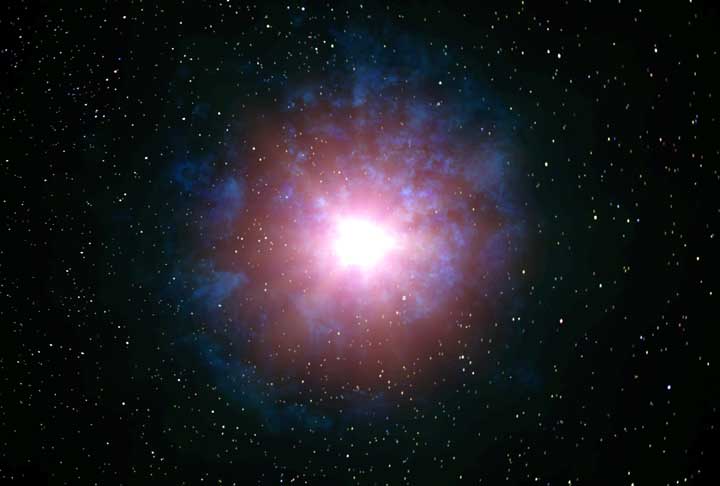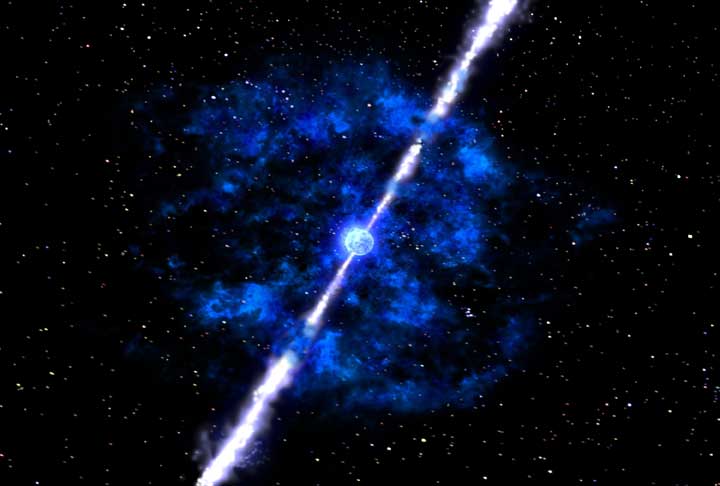 Link zur deutschen Version
dieser Seite
Link zur deutschen Version
dieser SeiteFireworks in the sky - 4 Gamma-ray bursts in one day
 Link zur deutschen Version
dieser Seite
Link zur deutschen Version
dieser Seite
On March 19, 2008, a total of 4 Gamma-Ray bursts (GRBs) were localized by
the Swift satellite, of which 3 have been also independently detected
by INTEGRAL. Among them, probably the brightest one we have
seen since INTEGRAL and Swift are looking for bursts.
For a summary of the findings on the 4 bursts of March 19, see
The analysis of GRB080319B led to the following publication in the
science magazin Nature:
In case of questions and comments: contact me at the APC. The
images on this page are artist's impressions of a GRB (Credit:
NASA/Zhang & Woosley). This outburst occured at 7:12 a.m. in the morning of March 19, and if one would
have looked at its position by chance, one could have seen it with the
naked eye (peak brightness was about 5.6 mag in the optical).
Also INTEGRAL detected this burst, probably caused by the Supernova
explosion of a very massive star. Unfortunately it appeared not to be in
the field of view of one of the imaging instruments, but was detected
in the heavy shielding which encloses the SPI spectrometer.
Many telescopes were pointed immediately at this GRB, revealing that
it was located probably at redshift 0.94 (it happened when the Universe was less than half as old as today), which means a (luminosity)
distance of about 7.5 billion light years away from us - imagine how
bright it has to be, to be visible by naked eye at that distance. In
fact, during its outburst, the GRB was 100 million billion times
(10E17) brighter than our sun, and still 10,000 times brighter than
the quasar 3C 273. A burst as bright as GRB 080319B which would happen
in the centre of our Milkyway, would appear much brighter than the
Sun. Unfortunately, such an event is assumed to be rather rare - we
expect to have one Gamma-Ray Burst in the Milkyway every 100,000 to
1,000,000 years, and a bright Gamma-Ray Burst would have to direct its
emission towards us, thus one would have to wait on average 1 to 100 billion
years for such an event in our own Galaxy.
This outburst occured at 7:12 a.m. in the morning of March 19, and if one would
have looked at its position by chance, one could have seen it with the
naked eye (peak brightness was about 5.6 mag in the optical).
Also INTEGRAL detected this burst, probably caused by the Supernova
explosion of a very massive star. Unfortunately it appeared not to be in
the field of view of one of the imaging instruments, but was detected
in the heavy shielding which encloses the SPI spectrometer.
Many telescopes were pointed immediately at this GRB, revealing that
it was located probably at redshift 0.94 (it happened when the Universe was less than half as old as today), which means a (luminosity)
distance of about 7.5 billion light years away from us - imagine how
bright it has to be, to be visible by naked eye at that distance. In
fact, during its outburst, the GRB was 100 million billion times
(10E17) brighter than our sun, and still 10,000 times brighter than
the quasar 3C 273. A burst as bright as GRB 080319B which would happen
in the centre of our Milkyway, would appear much brighter than the
Sun. Unfortunately, such an event is assumed to be rather rare - we
expect to have one Gamma-Ray Burst in the Milkyway every 100,000 to
1,000,000 years, and a bright Gamma-Ray Burst would have to direct its
emission towards us, thus one would have to wait on average 1 to 100 billion
years for such an event in our own Galaxy.
http://gcn.gsfc.nasa.gov/other/080319.gcn3 For the report about what INTEGRAL saw:
For the report about what INTEGRAL saw:
http://gcn.gsfc.nasa.gov/gcn3/7450.gcn3
and see the impressive light curve extracted from the INTEGRAL SPI-ACS
For a short movie of the outburst in the optical, see the outburst of GRB080319B
Broadband observations of the naked-eye gamma-ray burst GRB 080319B Last update: March 26, 2008 by V. Beckmann
Last update: March 26, 2008 by V. Beckmann